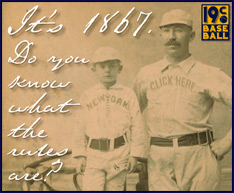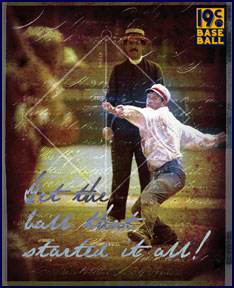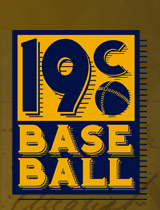History of the Hit Batsman (Continued)

pitched ball hitting the batter is listed as an unfair ball in DeWitt's Base Ball Guide 1876. This is to be counted toward the nine "unfair balls" or three balls that constituted giving the batter his first. Three unfair balls equaled one called ball.
The amateur rules listed in Beadle's Dime Base-Ball Player guide for 1876 specifically state that any pitched ball that hits the striker while he is in the lines of his position is to be a "unfair ball." A pitched ball that hit the batsman was no longer considered a "dead ball." The first pitched ball was allowed to be called by the umpire.
In the NL's second year of play the definition of a dead ball printed in Spalding's Guide was added to and clarified. This was the first year that an unfair ball specifically became a dead ball. Under the heading of "Dead Ball" the rule was written as follows, "All balls delivered to the bat which shall touch the striker's bat without being struck at, or his (the batsman's) person while standing in his position, or which shall hit the person of the umpire - unless it be a passed ball - shall be considered dead balls and shall be so called by the umpire, and no players shall be put out, base be run, or run be scored on any such ball, but if a dead ball be also an unfair ball, it shall be counted as one of the nine unfair balls which shall entitle the striker to a base."
DeWitt's 1877 guide lists a clear explanation stating that a pitched ball hitting the batter is to be called an "unfair ball" and is to be considered a "dead ball."
Beginning with the 1878 season the umpire was allowed to fine players between $10 and $25 dollars for detrimental conduct towards the game, the umpire, an opposing player or the audience. Once an umpire imposed a fine on a player he notified the captain of the offending team of the reason and the amount of the fine. The club had 10 days to "transmit the amount of such a fine to the Secretary of the League."
The fine amount for the 1879 season changed and ranged from $5 to $50 and for the first time a pitcher, in the judgment of the umpire, who intentionally hit a batter with a pitched ball, was to be fined between $10 and $50. The fine was to be paid in the same manner as in 1878. The ball was still declared dead, no run could be scored or base runner advance and the pitcher was assessed an unfair ball. The institution of the fine gave the pitchers economic reasons to hit or not intentionally hit the striker.
The hit batsman rule listed in Beadle's Dime Base Ball Player for the 1880 season, amateur rules, was changed. The fine an umpire was allowed to assess during a game was reduced and ranged from $5 to $10. However, a pitcher was still fined between $10 and $50 for intentionally hitting batter with a pitched ball in the judgment of the umpire and assessed a ball (eight balls gave the batter his base on called balls). These fines, once announced to the captain of the offending club, were to be paid immediately to the home club, most likely the home club's Secretary. If the fine was not paid or "arranged to be paid," the game was to be forfeited.
The professional rules, Spalding Guide, 1880, maintained fining a pitcher if the umpire felt it was done intentionally. Under the heading "Definitions," the dead ball rule was shortened to the following, "A Dead Ball is a ball delivered to the bat by the Pitcher, that touches the Batsman's bat without being struck at, or any part of the Batsman's person while standing in his position, or any part of the Umpire's person without first passing the Catcher."
In the "Game" section the dead ball is explained further. It states, "When a Dead Ball is declared by the Umpire, no player shall be put out, base be run, or run be scored on such ball, unless such ball be also the eight Unfair Ball, that entitled the striker to a base, in which case the striker shall take First Base, and any Base-Runner thereby forced to vacate a base shall take one base without being put out, and if a base thus taken be the Home Base the run shall be scored."
The 1881 Beadle's Dime Base Ball Player, which was the last year of printing, listed the same fines for the pitcher only from the previous season but did not state how the fine was to be collected.
The professional rule regarding the definition and outcome of a hit batsman did not change and the fine also remained the same.
The American Association of Professional Base Ball Clubs began play in 1882 and added to the NL's existing "Dead Ball" rule. The AA's rule stated, "A ball delivered to the bat by the Pitcher that touches the Batsman's bat without being struck at, or any part of the Batsman's person or clothing while standing in his position without being struck at or any part of the Umpire's person or clothing without first passing the catcher."
The AA made a distinction that the NL did not. The ball was now dead if the clothing of the batter or umpire was hit by the pitched ball. If a dead ball was called and met the above requirements it was one of the seven called balls needed or a base on balls. No fine was specified to be given to the pitcher if the batsman was hit by a pitched ball.
The National League made no changes to a batter hit by a pitched ball for the 1882 season and did not consider the clothing of the batsman or umpire able to deem the ball dead.
In 1884 the American Association made no changes to the definition of a dead ball, but in "The Game" section stated that a base-runner was allowed to advance one base without being put out (providing he did so on the run) when the following occurred, "If a Batsman be solidly hit by a ball from the Pitcher when he evidently cannot avoid the same, he shall be given his base by the umpire as a penalty." Thus, the AA became the first league to allow the batsman to receive his base after being hit by a pitched ball. If the batsman made no effort to avoid the ball an unfair ball was called and counted toward the seven needed for the batter to receive his base on called balls. The AA still did not fine the pitcher for intentionally hitting the batsman.
The Rules: History of the Hit Batsman Continued ![]()
The Rules of the Game: A Compilation of the Rules of Baseball 1845–1900 ![]()






